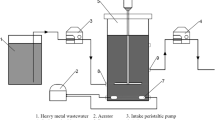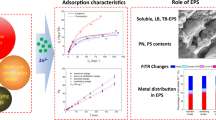Abstract
The goal of this research is to compare the metal binding characteristics of an anoxic selector activated sludge system and a conventional activated sludge system. Metal biosorption by biomass harvested from experimental systems was determined by a series of batch experiments. Heavy metals studied in this research were zinc, cadmium, and nickel. The sorption isotherm showed that the selector sludge had significantly higher sorption capacity than did the control sludge. Metal biosorption behavior closely followed a Freundlich isotherm model for equilibrium concentrations. ECP contents of biomass estimated by alkali extraction technique showed that ECP levels in the selector sludge significantly higher than that in the sludge harvested from the conventional system, indicating that the higher metal sorption capacity of selector sludge may be due to the selection of the ECP-producing bacteria (i.e., Zoogloca sp.) by the selector system.
Similar content being viewed by others
References
Jenkins, D., M. G, Richard, and G. T. Daigger (1993)Alanual on the Causes and Control of Activated Sludge Bulking and Foaming. Lewis, Ann Arbor, MI, USA.
Cha, D. K., D. Jenkins, W. P. Lewis, and W. H. Kido (1992) Process control factors influencingnocardia popu-lations in activated sludge.Water Environ Res. 64: 37–43.
Cha, D. K. (1990)Process Control Factors Influencing NocardiaPopulation in Activated Sludge. Ph. D. disserta-tion, University of California at Berkeley.
Brown, H. G., C. P. Hensley, G. L. McKinney, and J. L. Robinson (1973) Efficiency of heavy metals removal in municipal sewage treatment plant.Environ. Lett. 5: 103–114.
Tien C. T. and C. P. Huang (1987) Adsorption behavior of cu(ii) onto sludge particulate surfaces.J. Environ. Eng. 113: 285–299.
Su, M. C., D. K. Cha, and P. R. Anderson, (1995) Influence of selector technology on heavy metal removal by activated sludge: secondary effects of selector technology.Wat. Res. 29: 971–976.
Brown, M. J. and J. N. Lester (1979) Metal removal in activated sludge: the role of bacterial extracellular polymers.Wat. Res 13: 817–837.
Brown, M. J. and J. N. Lester (1982) Role of bacterial extracellular polymers in metal uptake in pure bacterial culture and activated sludge: I. Effect of metal concentration.Wat. Res. 16: 1539–1548.
Lawson, P. S., R. M. Sterritt, and J. N. Lester (1984) Adsorption and complexation mechanisms of heavy metal uptake in activated sludge.J. Chem. Tech. Biotechnol. 34B: 253–262.
Geesey, G. G. and L. Jang (1989) Interactions between metal ions and capsular polymers pp. 325. In: T.J. Beverage and R. J. Doyle (eds.),Metal Ions and Bacteria, Wiley Interscience, NY, USA.
Dugan, P. R. and Pickrum H. M. (1972) Removal of mineral ions from water by microbial produced polymer. pp. 1019–1038. In:Proceedings of the 27th Annual Purdue Ind. Waste Conf., Purdue Univ., West Lafayette, IN, USA.
Rudd, T., R. M. Sterritt, and J. N. Lester (1983) Stability constant and complexation capacities of complexes formed between heavy metals and extracellular polymers from activated sludge.J. Chem. Tech. Biotechnol. 33A: 374–380.
Noberg, A. B. and H. Persson (1984) Accumulation of heavy-metal ions byZoogloea rantigera.Biotechnol. Bioeng. 26: 239–246.
Friedman, B. A. and P. R. Dugan (1968) Concentration and accumulation of metallic ions by the bacterium.Zoogloca. Dev. Ind. Microbial. 9: 381–388.
van Niekerk, A. M., D. Jenkins, and M. G. Richard (1987) The competitive growth ofZoogloea ramigera and type 021N in activated sludge and pure culture: A model for low F/M bulking.J. Wat. Pollut. Control Fed. 59: 262–273.
APHA (1992)Standard Methods for the Examination of Water and Wastewater, 18th ed. American Public Health Association, Washington, DC, USA.
Brown, M. J. and J. N. Lester (1980) Comparison of bacterial extracellular polymer extraction methods.Appl. Environ. Microbiol. 40: 179–185.
Author information
Authors and Affiliations
Corresponding author
Rights and permissions
About this article
Cite this article
Niec, J.H., Cha, D.K. Influence of anoxic selectors on heavy metal removal by activated sludge. Biotechnol. Bioprocess Eng. 5, 431–435 (2000). https://doi.org/10.1007/BF02931943
Received:
Accepted:
Issue Date:
DOI: https://doi.org/10.1007/BF02931943




